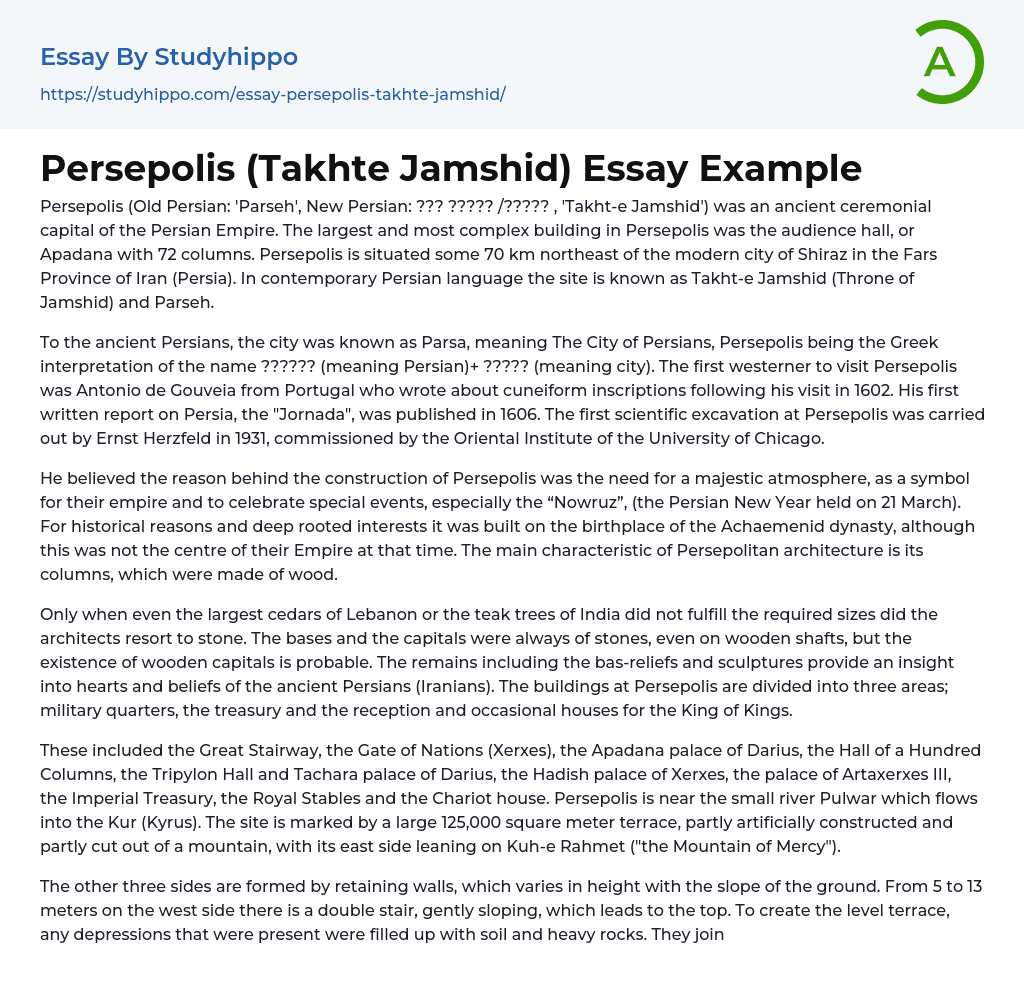

Persepolis The Capital of Persia for Hours Achaemenides Essay Example
The largest and most complex building in Persepolis was the audience hall, or Apadana with 72 columns. Persepolis is situated some 70 km northeast of the modern city of Shiraz in the Fars Province of Iran (Persia). In contemporary Persian language the site is known as Takht-e Jamshid (Throne of Jamshid) and Parseh.
To the ancient Persians, the city was known as Parsa, meaning The City of Persians, Persepolis being the Greek interpretation of the name (meaning Persian)+ (meaning city). The first westerner to visit Persepolis was Antonio de Gouveia from Portugal who wrote about cuneiform inscriptions following his visit in 1602. His first written report on Persia, the "Jornada", was published in 1606. The first scientific excavation at Persepolis was carried out by Ernst Herzfeld in 1931, commissioned by the Oriental Institute of the University of
...Chicago.
He believed the reason behind the construction of Persepolis was the need for a majestic atmosphere, as a symbol for their empire and to celebrate special events, especially the “Nowruz”, (the Persian New Year held on 21 March). For historical reasons and deep rooted interests it was built on the birthplace of the Achaemenid dynasty, although this was not the centre of their Empire at that time. The main characteristic of Persepolitan architecture is its columns, which were made of wood.
Only when even the largest cedars of Lebanon or the teak trees of India did not fulfill the required sizes did the architects resort to stone. The bases and the capitals were always of stones, even on wooden shafts, but the existence of wooden capitals is probable. The remains including the bas-reliefs and sculptures provide an insight into hearts
and beliefs of the ancient Persians (Iranians). The buildings at Persepolis are divided into three areas; military quarters, the treasury and the reception and occasional houses for the King of Kings.
These included the Great Stairway, the Gate of Nations (Xerxes), the Apadana palace of Darius, the Hall of a Hundred Columns, the Tripylon Hall and Tachara palace of Darius, the Hadish palace of Xerxes, the palace of Artaxerxes III, the Imperial Treasury, the Royal Stables and the Chariot house. Persepolis is near the small river Pulwar which flows into the Kur (Kyrus). The site is marked by a large 125,000 square meter terrace, partly artificially constructed and partly cut out of a mountain, with its east side leaning on Kuh-e Rahmet ("the Mountain of Mercy").
The other three sides are formed by retaining walls, which varies in height with the slope of the ground. From 5 to 13 meters on the west side there is a double stair, gently sloping, which leads to the top. To create the level terrace, any depressions that were present were filled up with soil and heavy rocks. They joined the rocks together with metal clips. Gray limestone was the main material used in building Persepolis. To reach the top terrace, the construction of a broad Stairway, 20 meters above the ground, was planned to be the only main entrance. This was begun around 518 BC.
The dual stairway, known as the Persepolitan stairway, was built in a symmetrical manner on the western side of the Great Wall. The 111 steps were 6. 9 meters wide with treads of 31 centimeters and rises of 10 centimeters. Originally the steps were believed to
have been constructed to allow for nobles and royalty to ascend by horseback, new theories suggest that this was to allow visiting dignitaries to in fact walk up the stairs while keeping a regal appearance, permissible by the ease in which the stairs could be climbed due to the small distance between each step.
The top of the stairways led to a small yard in the northeastern side of the terrace, opposite the Gate of Nations. After natural rock had been leveled and the depressions filled in, the terrace was prepared. Major tunnels for sewage were dug underground through the rock. A large elevated water storage tank was carved at the eastern foot of the mountain. Professor Olmstead suggested the cistern was constructed at the same time the construction of the towers began.
The uneven plan of part of the foundation of the terrace acted like a castle whose angled walls enabled its defenders to target any section of the external front. Diodorus writes that Persepolis had three walls with ramparts, which all had towers to provide protection space for the defense personnel. The first wall was 7 meters tall, the second, 14 meters and the third wall, which covered all four sides, was 27 meters in height, though no presence of the wall exists in modern times.
- Arch essays
- Area essays
- Building essays
- Architecture essays
- Design essays
- Graffiti essays
- Graphic essays
- Interior design essays
- Painting essays
- Photography essays
- Sculpture essays
- Typography essays
- Automotive essays
- Automotive Industry essays
- Commerce essays
- Construction essays
- E Commerce essays
- Grocery stores essays
- Paper Industry essays
- Pharmaceutical industry essays
- Pharmacy essays
- Polymers essays
- Real Estate essays
- Textile Industry essays
- 12 Angry Men essays
- A beautiful mind essays
- A Separation essays
- Alfred Hitchcock essays
- American Beauty essays
- American Films essays
- Animation essays
- Avatar essays
- Blade Runner essays
- Bollywood essays
- Bond essays
- Bridge essays
- Cinema Of The United States essays
- Comedies essays
- David essays
- Dead Poets Society essays
- Do The Right Thing essays
- Documentary essays
- English-Language Films essays
- Erin Brockovich essays
- Film Analysis essays
- Film Editing essays
- Film Noir essays
- Film Techniques essays
- Finding Forrester essays
- Forrest Gump essays



